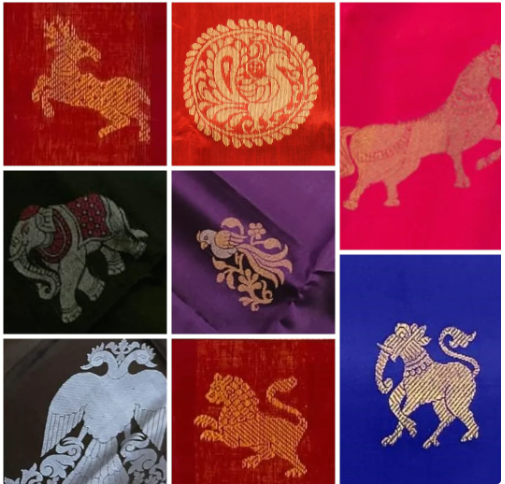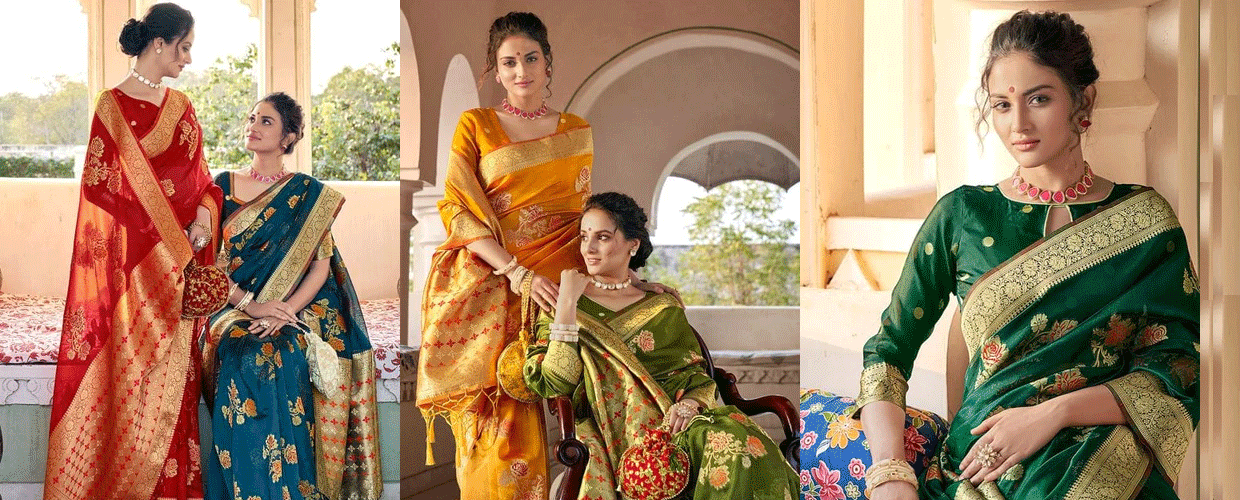
Traditional Kanjivaram Motif Saree Trends!! - Young Women Fashion & Lifestyle
Motifs are the building blocks of a design pattern and are often inspired by nature and cultural, architectural and socio-economic influences. Indian motifs are unique, vibrant and full of life, and they hold the key to our past, shaped by different eras and dynasties. Each motif has its own rich story and cultural significance, and this week's blog will explore the meaning and history behind the popular motifs, which symbolize life and eternity.
Traditional sarees are tales of cultures from the treatise of time. Uncloaking these weaving crafts brings us enriched motifs and patterns from the past.

The Peacock Motif Kanjivaram Saree:
The peacock, known for its wealth, beauty, and royalty, holds a place of prestige and pride in India, where it is the national bird. Historically, it has been used in the adornment of garments worn by kings and queens, as well as in jewellery and paintings of the 15th century. Today, the decorative peacock motif is commonly used in Kanjivaram and Banarasi sarees, on zari and brocade borders, embroidered pallus, and even on the body of the saree. This motif continues to be popular among lovers of Kanjivaram sarees.
The Peacock's Eye And Lilting Waves Motif Kanjivaram Saree:
The Peacock's Eye saree is a traditional Indian garment featuring a design of "lilting waves and glittering eyes." The saree is typically made from a lightweight fabric such as silk or chiffon and is draped around the body in a specific way to create a flowing and elegant look. The design of the saree often features intricate patterns and designs, with the "peacock's eye" pattern being a popular choice. This saree is popularly worn on special occasions such as weddings, religious festivals, and other formal events.
The Peacock's Eye motif is a traditional design featured on Kanjivaram sarees, a type of traditional Indian garment. The motif is associated with many Hindu gods and legends. According to one story, the leader of the gods, Indra, was once protected by a peacock and in gratitude, the bird was given 1000 eyes on its tail. Another legend states that a peacock was banished to earth by the sun god Surya because of his vanity, and the tears of Surya's daughter turned into 'eyes' on the peacock's tail. Kanjivaram weavers often feature the Peacock's Eye motif woven closely together across the body, pallu or along sari borders. The sparkling 'eyes' in the design bring alive a timeless tradition of elegance on a Kanjivaram Silk Sari.
The Mango motif is a popular and enduring design in traditional Indian art and is often featured on Kanjivaram sarees. The mango is a significant fruit in Indian mythology (the young Lord Ganesha and his brother Lord Muruga having contested for it!) and has a strong presence in the Kanjivaram weaving tradition. The motif can be incorporated in various ways on the saree, such as small mangoes along the border or large mango patterns on the pallu.
Elephant Motif Kanjivaram Saree:
The elephant is highly respected for its strength and intelligence and is often worshipped in the form of Lord Ganesha. This animal, known for its friendly face, is commonly featured in temple pillars and sculptures. It is often associated with the Goddess of Wealth, Lakshmi, and also symbolizes royalty. The motif of elephants is frequently used to decorate the pallu of Kanchipuram sarees, adding a brilliant touch to their overall appearance. The Yaanai Yaali and Vanasinghram motifs have been used in Kanjivarams for many years, particularly in sarees worn for wedding ceremonies.
Temple Tradition Motif Kanjivaram Saree:
The influence of South Indian art and culture is evident in the intricate craftsmanship of Kanchipuram silk sarees. The weavers drew inspiration from grand temples of religious importance and incorporated symbolic elements from their architecture into their designs. A particularly recognizable design element in these sarees is the Gopuram motif border, which is synonymous with Kanchipuram silk sarees.
Winged Horse Motif Kanjivaram Saree:
The horse symbolizes freedom and the ability to break free from constraints. It inspires a sense of hope for liberation and is often associated with independence, vitality, and lushness in mythology. In modern times, the horse motif has been used in various forms of textile art, such as Kanjivaram silk sarees, Kalamkari fabrics, and block-printed sarees.









Leave a comment
This site is protected by hCaptcha and the hCaptcha Privacy Policy and Terms of Service apply.